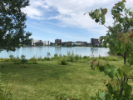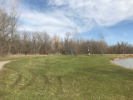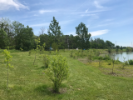Lake LaSalle's restoration puts student club project to use; enhances sustainability on campus

The newest addtion to Lake LaSalle's restoration is a rainwater collection system, built by UB-ESW. It sits in the middle of a graden on the lake's shoreline.
By Peter Murphy
Published July 1, 2019
Over the past two years, UB environmental engineering graduate student Molly Dreyer has led efforts to mitigate erosion and enhance aesthetics to Lake LaSalle’s shoreline. In 2019, Dreyer worked with a team of seniors in the School of Engineering and Applied Sciences to add a water collection component thanks to a 2016 project.
A collaboration three years in the making
“It’s kind of funny how it all worked out,” Dreyer says, “they did all this work a few years ago and finally get to see their project in use before they graduate.”
Dreyer has led a number of initiatives associated with the Lake LaSalle restoration project. She designed the project in 2017, implemented it a year later, and added the rainwater collection structure this year as the next step in that process. The structure provides Lake LaSalle with a few benefits, according to Dreyer.
“It will definitely ensure that the plants we just installed will have a healthy establishment period,” Dreyer says, “the long-term goal is for the site to be self-sustaining, but for the first couple of years, the plants are going to need water maintenance to make sure they grow.”
The rainwater collection system was originally designed by UB’s Engineers for a Sustainable World (ESW-UB) student chapter for the 2016-2017 New York State Pollution Prevention Institute’s (NYSP2I) R&D Student Competition. Student teams throughout New York State develop solutions to real-world environmental challenges. According to environmental engineering alumni and incoming MS student Austin Izzo, the structure was first designed for UB’s Campus Garden located near Greiner Hall.
“The Campus Garden lacked water access,” Izzo says, “it is isolated, and there are no wells out there. The Campus Garden was also going to be moving, so we developed this portable rainwater collection structure that could collect enough rainwater for the garden.”
The structure was stored in Jarvis Hall on UB’s North Campus as the team awaited an installation date. Environmental engineering professor James Jensen is the faculty advisor to ESW-UB, and worked with Dreyer during the initial phases of the Lake’s restoration project, and he first introduced the idea of having Dreyer and ESW-UB collaborate.
“Dr. Jensen came out to see the lake on one of planting days, and said ‘oh, you know, we’ve got a watering system in Jarvis that would be great for this.’” Dreyer says, “He saw all the new plants and kind of put two and two together. He realized the watering system would really benefit the site.”
Izzo, Austin Reese, Mark Geraci and Alec Ruby were the original team members on the NYSP21 project, and each of them were underclassmen when the project was initially designed. Three of the four students graduated in May 2019, and without the Lake restoration project, they may not have had an opportunity to actually see their rainwater collection system in use.
“Austin (Izzo) and I had collaborated in the past, and we had been talking about this idea for about a year,” Dreyer says, “then in the spring we all kind of said ‘ok, it’s go time now’ because most of the original team members were graduating.”
A team of Izzo, other ESW-UB members, Dreyer, Jensen and a few other students got together to install the structure on Friday, May 10. The rainwater collection system will be a seasonal fixture on the Lake, from April/May to October, and would ideally be in place for at least four to five years as the newly installed plants become more established and eventually self-sustaining.
The project originated with ESW-UB three years ago, and some of the team members hope it will continue to be an ESW-UB project in the future. “We’re hoping that perhaps this can be an ongoing project that will engage future ESW students as well.”
JOIN OUR MAILING LIST
Sign up to receive UB CSEE's electronic newsletter, delivered to your inbox!
Companies will be on campus regularly this semester to discuss engineering opportunities and share information applicable to all students.
View the seminar speaker schedule here



